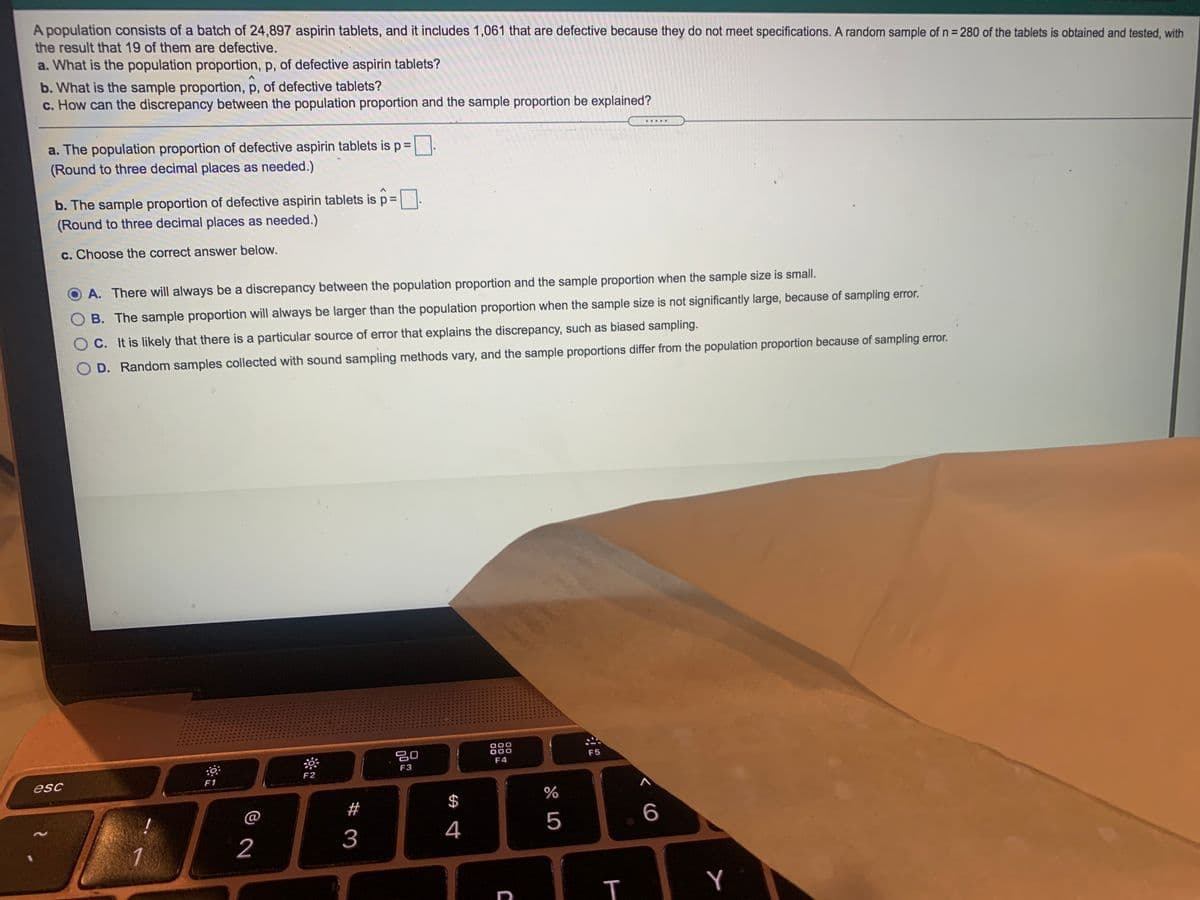A population consists of a batch of 24,897 aspirin tablets, and it includes 1,061 that are defective because they do not meet specifications. A random sample of n= 280 of the tablets is obtained and tested, with the result that 19 of them are defective. a. What is the population proportion, p, of defective aspirin tablets? b. What is the sample proportion, p, of defective tablets? c. How can the discrepancy between the population proportion and the sample proportion be explained? a. The population proportion of defective aspirin tablets is p= (Round to three decimal places as needed.) b. The sample proportion of defective aspirin tablets is p=. (Round to three decimal places as needed.) c. Choose the correct answer below. O A. There will always be a discrepancy between the population proportion and the sample proportion when the sample size is small. O B. The sample proportion will always be larger than the population proportion when the sample size is not significantly large, because of sampling error. O C. It is likely that there is a particular source of error that explains the discrepancy, such as biased sampling. O D. Random samples collected with sound sampling methods vary, and the sample proportions differ from the population proportion because of sampling error.
A population consists of a batch of 24,897 aspirin tablets, and it includes 1,061 that are defective because they do not meet specifications. A random sample of n= 280 of the tablets is obtained and tested, with the result that 19 of them are defective. a. What is the population proportion, p, of defective aspirin tablets? b. What is the sample proportion, p, of defective tablets? c. How can the discrepancy between the population proportion and the sample proportion be explained? a. The population proportion of defective aspirin tablets is p= (Round to three decimal places as needed.) b. The sample proportion of defective aspirin tablets is p=. (Round to three decimal places as needed.) c. Choose the correct answer below. O A. There will always be a discrepancy between the population proportion and the sample proportion when the sample size is small. O B. The sample proportion will always be larger than the population proportion when the sample size is not significantly large, because of sampling error. O C. It is likely that there is a particular source of error that explains the discrepancy, such as biased sampling. O D. Random samples collected with sound sampling methods vary, and the sample proportions differ from the population proportion because of sampling error.
Holt Mcdougal Larson Pre-algebra: Student Edition 2012
1st Edition
ISBN:9780547587776
Author:HOLT MCDOUGAL
Publisher:HOLT MCDOUGAL
Chapter11: Data Analysis And Probability
Section11.5: Interpreting Data
Problem 1C
Related questions
Question

Transcribed Image Text:A population consists of a batch of 24,897 aspirin tablets, and it includes 1,061 that are defective because they do not meet specifications. A random sample of n = 280 of the tablets is obtained and tested, with
the result that 19 of them are defective.
a. What is the population proportion, p, of defective aspirin tablets?
b. What is the sample proportion, p, of defective tablets?
c. How can the discrepancy between the population proportion and the sample proportion be explained?
.....
a. The population proportion of defective aspirin tablets is p =
(Round to three decimal places as needed.)
b. The sample proportion of defective aspirin tablets is p= |.
(Round to three decimal places as needed.)
c. Choose the correct answer below.
A. There will always be a discrepancy between the population proportion and the sample proportion when the sample size is small.
B. The sample proportion will always be larger than the population proportion when the sample size is not significantly large, because of sampling error.
C. It is likely that there is a particular source of error that explains the discrepancy, such as biased sampling.
D. Random samples collected with sound sampling methods vary, and the sample proportions differ from the population proportion because of sampling error.
000
吕0
F5
F4
F3
F2
esc
F1
23
$
3
4
5
2
Y
EGO
Expert Solution
This question has been solved!
Explore an expertly crafted, step-by-step solution for a thorough understanding of key concepts.
This is a popular solution!
Trending now
This is a popular solution!
Step by step
Solved in 4 steps

Recommended textbooks for you

Holt Mcdougal Larson Pre-algebra: Student Edition…
Algebra
ISBN:
9780547587776
Author:
HOLT MCDOUGAL
Publisher:
HOLT MCDOUGAL

Holt Mcdougal Larson Pre-algebra: Student Edition…
Algebra
ISBN:
9780547587776
Author:
HOLT MCDOUGAL
Publisher:
HOLT MCDOUGAL